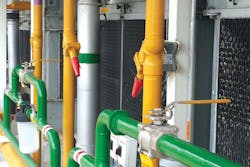In the November/December 2017 issue of Water Technology, part 1 of this two-part series, “How To Increase Cooling Tower Efficiency,” discussed water source impurities affecting circulating water systems, as well as cooling tower water treatment methods, the importance of the scaling indices in cooling tower applications and biological treatment methods.
To reduce wastewater generation (wastewater streams emanating from cooling tower blowdown, boiler blowdown, equipment and media cleaning), facility designers review and analyze many options. These options include: recycle, reuse and increasing cycles of concentration. Recycle and reuse options can involve additional unit operations such as sidestream filtration or application of specialized media.
Definitions
The following are key terms and definitions related to cooling tower water systems and factors to consider when designing cooling tower water systems.
Evaporation rate
This is the amount of water – in gallons per minute (gpm) – lost to the evaporation as the air passes through the evaporating cooling tower. It is roughly calculated using the following formula. (Note: This formula provides an acceptable approximate rate of evaporation; psychometric charts would yield a more accurate estimation.)
Evaporation = CFM (thousands) * [EDBT-LDBT] / 500
EDBT: Entering dry bulb temperature (air) deg F
LDBT: Leaving dry bulb temperature (air) deg F
CFM: Cubic feet per minute (air)
When designing cooling tower water systems, it is recommended to use worst-case scenario, including maximum evaporation rate and blowdown.
Blowdown
Blowdown is performed to maintain the circulating water chemistry in prescribed limits. After reaching the limits on solids in the circulating water, some portion of the circulating water is sent to a drain or outfall, and equal amounts of fresh makeup water is added to the system. The amount of water that is blown down to outfall depends on evaporation rate and cycles of concentration. It is calculated using the following equation:
Blowdown = Evaporation rate (gpm) / (COC-1)
COC: Cycles of concentration
Makeup water
This is the amount of freshwater added to the cooling water system. It is typically equal to the rate of blowdown plus the evaporation and drift losses in the cooling water system.
Makeup water = Evaporation and drift loss rate (gpm) + blowdown rate (gpm)
When blowdown and evaporation rates are known, required makeup water can be calculated. Controlling these parameters can be instituted using COC calculations and establishing circulating water chemistry using the targeted scaling indices.”
Scaling indices for cooling tower water systems
The three indices normally used are: Langelier saturation index (LSI), Puckorius (or practical) scaling index (PSI), and Ryznar stability index (RSI). One of the best tests for determining the scale or corrosion-causing tendencies of the water source is the LSI.
Saturation indices can be calculated when parameters – namely calcium hardness, total alkalinity, pH, total dissolved solids (TDS) and water temperature – are known.
Drift
These are the water droplets that are lost from the cooling water systems. Many systems use drift eliminators in the airflow path to curtail such losses.
Dry bulb temperature (DBT)
DBT is temperature in degrees Fahrenheit, measured by the ordinary thermometer.
Wet bulb temperature (WBT)
WBT is temperature in degrees Fahrenheit measured by the ordinary thermometer with a water-moistened wick around the bulb. If the surrounding air of the cooling tower system has moisture-holding potential (that means it is not at 100-percent humidity), then the water in the wick will evaporate and induce the cooling effect, resulting in a measurement that is below the DBT, which is termed as WBT.
The basis of the design of any cooling tower is the WBT of the air entering the cooling tower. This is selected based on the site location and prevailing operating conditions. Selection of the design basis WBT should cater to the facility location and results in optimal outlet water temperature when peak load is experienced at the respective facility.
If the actual WBT is higher than anticipated in the basic design, one can experience warmer water at the outlet because sufficient cooling effect cannot be derived from a given cooling tower. In contrast, if the WBT is lower than anticipated, a larger cooling tower than required may get installed. Hence, it is imperative that due diligence is carried out to establish proper WBT during the design phase.
Alkalinity
Alkalinity in the water is caused by the presence of carbonates, bicarbonates and hydroxides.
M alkalinity is termed as methyl orange alkalinity or total alkalinity (titration endpoint of 4.4). Below a pH of 4.4, there are no carbonates or bicarbonates or free hydroxyl radicals. Below this pH, free mineral acidity makes its presence known. This means that, at or lower than a pH of 4.4, there is enough hydrogen ion activity in the water to cause the presence of H2CO3, HCI and others.
P alkalinity is termed as phenolphthalein alkalinity and is present only when free carbon dioxide (CO
This can be represented by the following equations:
P alkalinity = [OH] + 1/2 [CO3]
M alkalinity = [OH] + [CO3] + [HCO3]
Scaling index values
Scaling indices can be easily computed using spreadsheet tools. The formulae associated with such calculations are:
PSI = 2(pHs)-pHeq
RS1= 2(pHs)-pH
LSI = pH-pHs
pHs = 9.30+(A+B)-(C+D)
pHeq = 1.465(log(TA)+4.54)
Factors A, B, C and D are derived using total dissolved solids (TDS), temperature, calcium hardness and alkalinity.
Positive LSI values indicate scaling tendencies, whereas negative LSl values indicate corrosive tendencies. For example, an LSI value of 1 to 3 represents severe to very severe extreme scaling. At the other end of the scale, an LSI value of (-)1 to (-)2 would represent moderate to strong corrosive tendencies.
Circulating water chemistry
This is controlled to provide LSI of 0.5 or RSI of 6 and/or PSI of 6.5. The aforementioned factors that determine the scaling indices are interdependent, and controlling each of them separately is not feasible. In practical terms, indices are set using makeup water chemistry and number of cycles of concentration (COC). Maximum COC that can be maintained using available makeup water source and the maximum evaporation rate define the maximum required blowdown. When blowdown and evaporation rates are known, required makeup water can be calculated. Controlling these parameters can be instituted using COC calculations and establishing circulating water chemistry using the targeted scaling indices previously mentioned.
Iron and manganese
The presence of dissolved iron and manganese beyond 0.1 ppm and 0.05 ppm, respectively, can lead to formation of black iron oxide and bacterial infection in the circulating water system. All water supplies will have dissolved iron to a certain extent. Commonly used methods of coagulation and filtration are effective in the removal of these species. Copper will not usually be present in raw water supply but gets picked up through contact with copper surfaces in the circulating water systems.
Silica
In natural water bodies, dissolved silica or reactive silica is not present beyond 10 to 20 ppm unless the water source is from geologic formation that promotes higher amounts of silica in the groundwater, such as found in the southwestern U.S. Colloidal and other undissolved forms of silica can be removed by efficient pretreatment of raw water. Silica solubility is dependent on water temperature and pH. At a higher pH, silica tends to be more soluble. In the normal pH and temperature range, COC of the cooling water system is determined so that dissolved silica concentration does not exceed 100 ppm as SiO2. When raw water itself contains higher amounts of silica, then COC becomes severely restricted. The higher the COC that the cooling water system can be operated under, the lower the amount of makeup required.
Blowdown control
Two methods are commonly used to control blowdown. One method prescribes a preset constant flow to sewer. In this mode of operation, a set amount of water is blown down to sewer in relation to predetermined COC set by the highest known amount of evaporation rate. In this method, water may be wasted unless a seasonal change is performed to the setting of the blowdown rate.
Another method is to adjust the blowdown rate based on the conductivity of the circulating water, accounting for the seasonal changes in the rate of evaporation and for inherent process variables. This is accomplished by installing a conductivity sensor in the sump and constantly adjusting the blowdown valve. This is a preferred method adopted in most facilities.
If the available makeup water source is too high in suspended and dissolved solids, pretreatment of raw water to make it suitable for cooling tower makeup is essential. But how is the treatment scope and scale determined?
Circulating water chemistry limits
As previously stated, to maximize usage of water and minimize the wastewater discharge from the facility, it is highly desirable to engage a water treatment expert in designing the circulating water system and set the limits on its chemistry. These limits, described in the following section, are used to decide on optimal scale and scope of raw water treatment in combination with facility-specific chemical programs.
pH: 6.5 to 9.0 is a typical neutral pH range for circulating water. It is preferred that circulating water pH is controlled within these limits so that corrosive conditions do not form. Special consideration should be given for the requirement of alkaline conditions in the circulating water system.
Temperature: The typical maximum temperature for any circulating water is 120ºF; a higher temperature will need specific consideration for the design and materials employed in the system.
Scaling indices: As previously mentioned, circulating water chemistry is controlled to provide LSI of 0.5 or RSI of 6 and/or PSI of 6.5. This ensures that there is no excessive scale buildup and minimizes the corrosion of system components.
M alkalinity: 100 to 500 ppm as CaCO3.
Silica as SiO2: Maximum 100 ppm. One can operate cooling towers with circulating water containing up to 150 ppm of silica; however, special scale inhibitors must be employed. Silica scale containing calcium, magnesium and sodium silicate is very hard and difficult to remove from heat exchange surfaces. Hence, care must be taken that design basis COC does not exceed the silica solubility under the operating conditions.
- Iron: 3 ppm maximum in the circulating water
- Manganese: 0.1 ppm maximum in the circulating water
- Sulfides: Greater than 1 ppm can be corrosive to copper alloys, steel and galvanized steel
- Ammonia: 50 ppm maximum if copper alloys are present
Chlorine/bromine: Per the guidelines to avoid microbio contamination of the system, maintain a continuous free residual of 0.5 ppm in the circulating water up to a maximum of 1 ppm free residual (when performing shock chlorination).
Total dissolved solids (TDS): TDS in the circulating water is limited to 5,000 ppm maximum. Although TDS can be as high as 5,000 ppm in the circulating water, there are limits on individual ions such as calcium, which is typically limited to maximum 800 ppm as CaCO3.
Allowable magnesium content depends on pH, temperature and silica of the circulating water because a higher amount of hardness-causing ions can cause formation of complex silicate scale. There is no maximum limit on sodium because most sodium salts are highly soluble under the normal operating conditions. Chlorides should not be more than 300 ppm if the circulating cooling water will come in contact with galvanized iron or bare carbon steel. Sulfates are typically limited to 800 ppm; corresponding calcium sulfate solubility as well as common ion effects for precipitation are evaluated prior to establishing limits for sulfates in circulating water. Nitrate is a nutrient for bacterial growth; the amount of nitrates is limited to 300 ppm. Alkalinity levels are typically controlled by dosing a small amount of acid in the circulating water to suppress the formation of calcium carbonate scale. Otherwise, alkalinity is limited to 300 ppm, especially for wooden or galvanized iron cooling towers.
REFERENCES
- The NALCO Water Handbook, Second Edition, McGraw-Hill Publishing Company.
- Industrial Water Conditioning – Betz Handbook, Ninth Edition, 1991.
- Reverse Osmosis – Practical Guide to Industrial Users, Second Edition, Wes Byrne.
- Environmental Chemistry, Fourth Edition, A.K. De.
Ganesh Kamatkar is senior water technology specialist at Air Liquide North America. He is a chemical engineer with more than 20 years of experience in water and wastewater treatment plants, design and engineering. His experience involves ion exchange, reverse osmosis, ultrafiltration, sea water desalination, produced water treatment, recycle/reuse water projects and integrated zero liquid discharge plants involving ion exchange and membrane systems.





